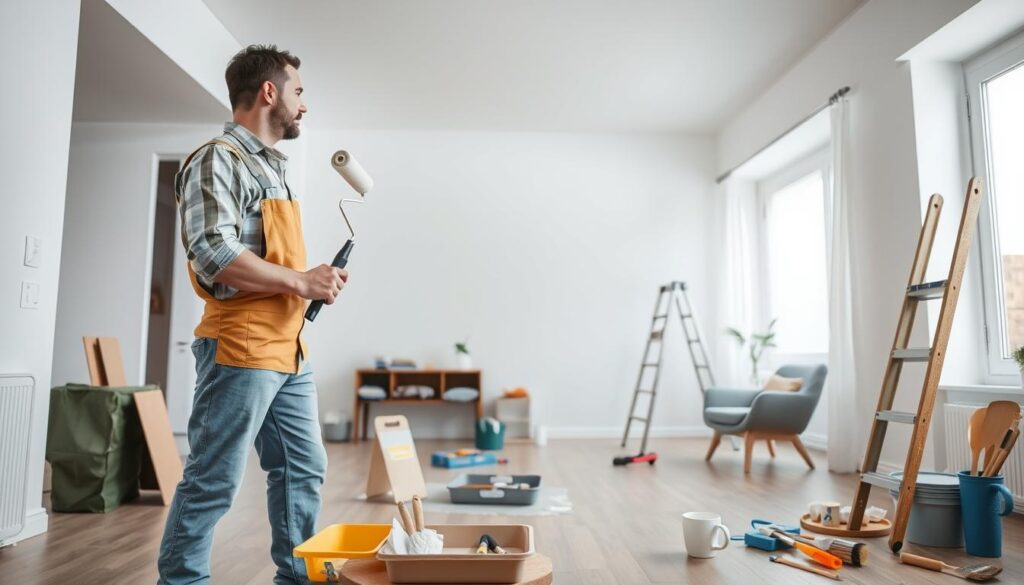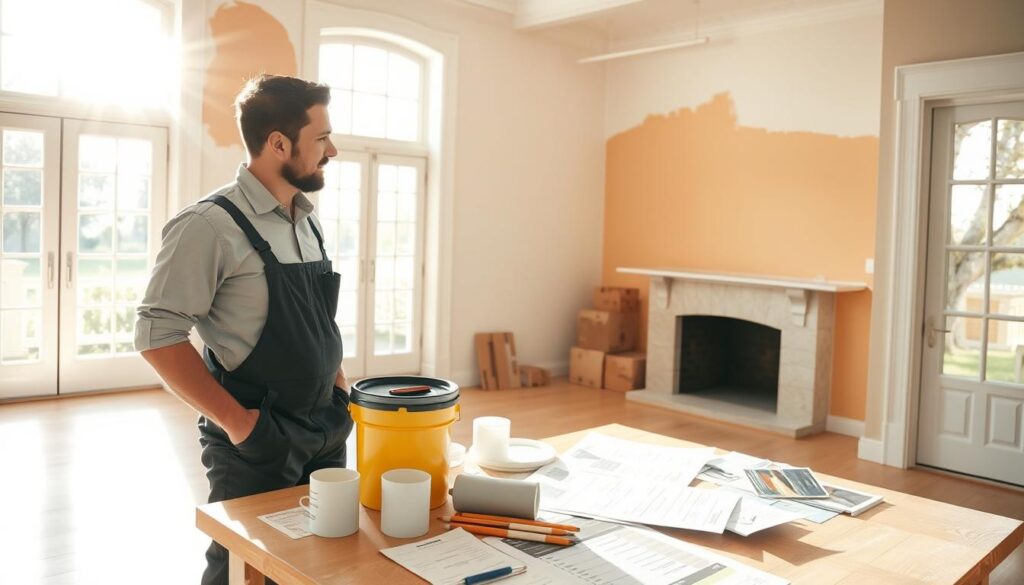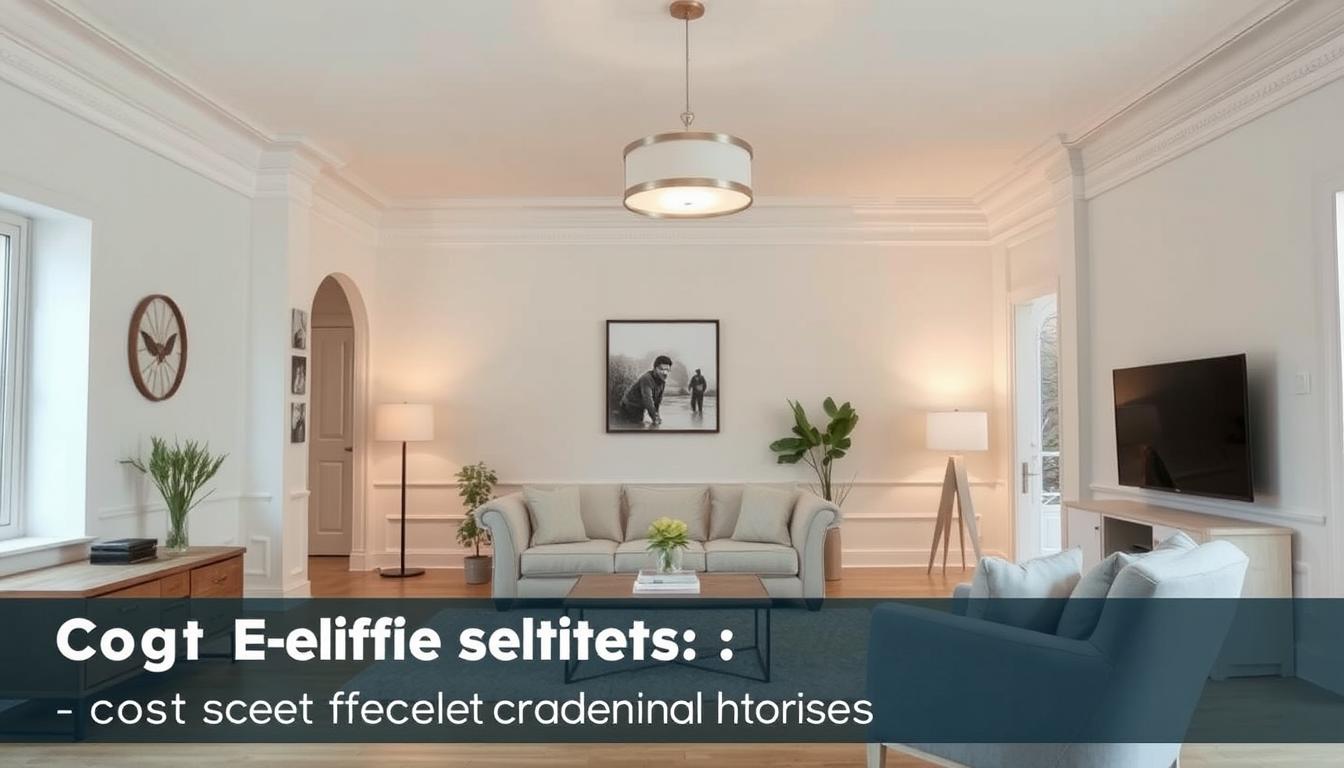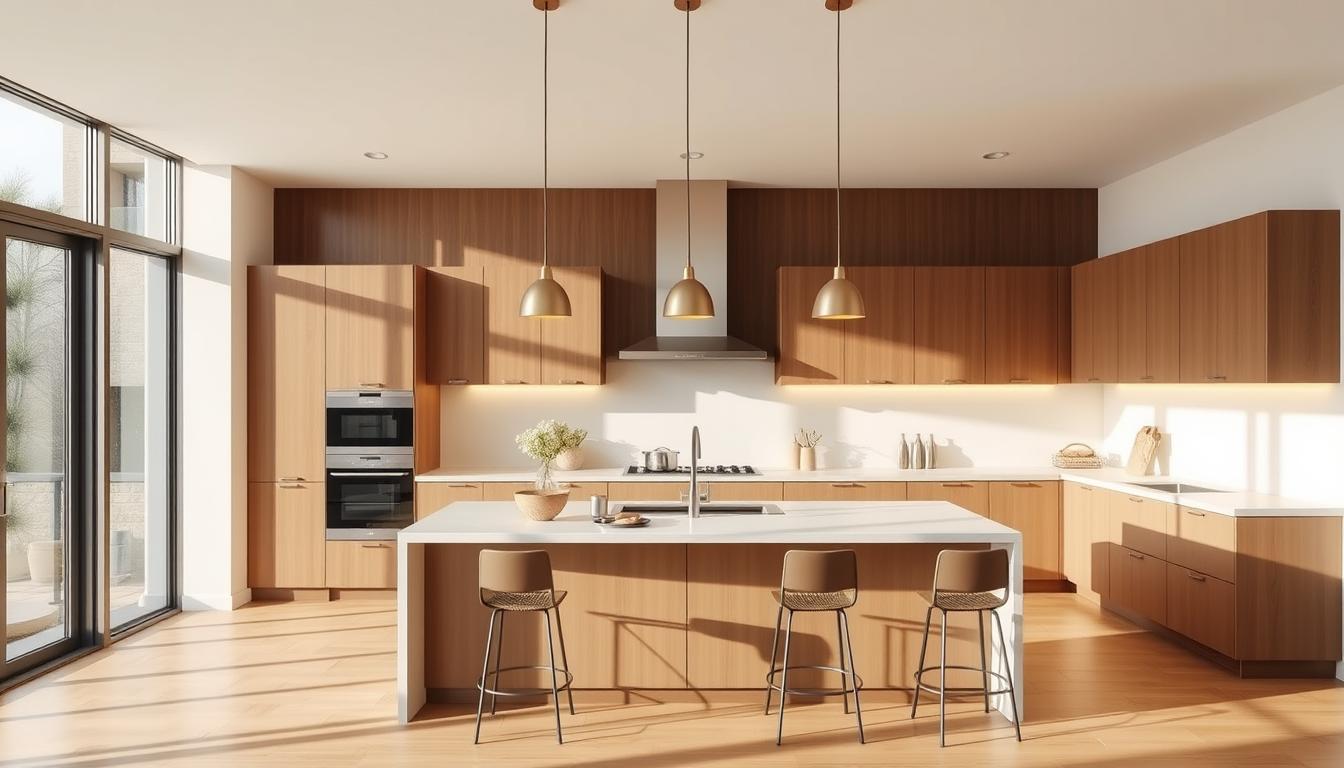Did you know the average homeowner spends about $2,014 to paint their home’s interior? Angi and Home Advisor say costs can be between $967 and $3,076. This makes it a big deal for homeowners wanting to update their space.
The interior house painting cost changes a lot. It depends on the home’s size and the paint quality. Whether you hire pros or do it yourself, knowing these points is key to figuring out the total cost.
We’ll dive into these details. We’ll give you tips on how to estimate the painting cost for home interiors.
Key Takeaways
- Average cost to paint a home’s interior is $2,014.
- Costs can range from $967 to $3,076.
- Factors affecting cost include home size and paint quality.
- Hiring professionals or DIY affects the total cost.
- Understanding these factors helps in estimating the total cost.
Understanding the Factors That Influence Painting Costs
Many things affect how much it costs to paint your home’s inside. The price can be anywhere from $1 to $8.68 per square foot. This depends on different factors.
Room Size and Type
The size and type of rooms in your home matter a lot. Bigger rooms or those with high ceilings need more paint and work. This makes the total cost go up.
For example, a big living room or a room with high ceilings will cost more than a small bedroom.
Here are some things that affect costs because of room size and type:
- Square footage of the room
- Height of the ceilings
- Number of windows and doors
- Complexity of the room’s design (e.g., number of corners, presence of trim)
Paint Quality and Type
The paint you pick is also very important. Better paints last longer and cover better but cost more. The finish, like flat or semi-gloss, also changes the price.
When picking paint, think about:
- Durability and washability
- Color retention
- Environmental impact (e.g., VOC levels)
- Brand reputation and quality
A painting expert says, “The right paint can make a big difference in how long and how good your walls look.” It’s about finding the right balance between cost, quality, and what you need.
Labor Costs
Labor costs are a big part of painting your home’s inside. Whether you do it yourself or hire someone, the cost can change a lot. Painters charge by the hour or by the job, based on their skill, where they are, and how hard the job is.
When thinking about labor costs, remember:
- The experience and reputation of the painting contractor
- The complexity of the painting task
- Local labor rates
Knowing these things helps you guess how much it will cost to paint your home’s inside. This way, you can make smart choices for your painting project.
Estimating the Cost Based on Room Size
The cost to paint a room changes a lot based on its size and details. It’s key to know the room’s size when figuring out painting costs. This affects how much paint and work are needed.
Small Rooms
Small rooms like bedrooms or bathrooms need less paint and work. This means they cost less to paint. The price can be between $350 to $850. The final cost can change based on the room’s design, ceiling height, and if repairs are needed.
Medium Rooms
Medium-sized rooms, like living rooms or dining rooms, fall in the middle for painting costs. They usually cost between $500 to $1,200. The price depends on the room’s details, like windows, doors, and special features.
Large Rooms
Big rooms, like great rooms or large master bedrooms, need more paint and work. This makes them more expensive. Painting a large room can cost from $600 to $1,500 or more. High ceilings or detailed trim can add to the cost.
Comparison of Different Room Sizes
Looking at the costs of painting different sized rooms shows how important room size is. For example, a small bedroom might cost $350 to paint, while a big living room could cost over $1,500. Knowing these differences helps homeowners plan and budget better for painting projects.
By thinking about the size and details of each room, homeowners can get a better estimate for painting costs. This helps with budgeting and deciding if they should hire professionals or do it themselves.
Breaking Down the Cost of Materials
To figure out the total painting cost, it’s key to look at material costs. Painting your home’s interior can be pricey. Knowing these costs helps you plan your project better.
Paint Prices
Paint costs a lot, and prices vary a lot too. A gallon of paint can cost between $20 and $70 or more. The paint’s quality impacts its price, coverage, and how long it lasts.
For example, better paint might cover more area and last longer. This could save you money over time.
Here’s a look at paint prices by quality:
| Paint Quality | Price Range per Gallon | Coverage per Gallon |
|---|---|---|
| Low | $20-$30 | 250-300 sq. ft. |
| Medium | $30-$50 | 350-400 sq. ft. |
| High | $50-$70+ | 400-450 sq. ft. |
Primer and Supplies
You’ll also need primer and supplies like brushes and rollers. Primer costs $10 to $30 per gallon, depending on quality. Supplies add $20 to $50 to your total cost, based on quality and amount.
Primer Costs: $10-$30 per gallon
Supply Costs: $20-$50 total
Tools and Equipment Rental
For big or complex jobs, you might rent equipment like ladders or sprayers. Rental prices vary a lot, based on equipment type and rental time. For instance, a sprayer can cost $40 to $100 per day.
Knowing material costs is key to planning your painting project’s budget. By breaking down these costs, you can plan and budget better for your home improvement.
Labor Costs: Hiring Professionals vs. DIY
When painting your home’s interior, it’s key to understand labor costs. You can choose to hire professionals or do it yourself. Labor costs can be a big part of the total cost, often making up 75% to 95% of it.

Average Hourly Rates for Painters
Professional painters usually charge between $20 and $50 per hour. The cost can change based on location, job complexity, and painter experience. For example, painting a room with detailed designs or high ceilings might cost more.
Advantages of Hiring Professionals
Hiring professionals has many benefits:
- Expertise: They have the skills to get a top-quality finish, including surface prep and material selection.
- Time-Saving: You save time, which you can use for other things.
- Quality Assurance: Good painting companies often offer warranties, giving you peace of mind.
DIY: Is It Worth the Effort?
Doing it yourself can save money on labor costs. But, think about these points:
- Skill Level: Be honest about your painting skills. Bad painting can cost more later.
- Time Commitment: Painting takes a lot of time, more if you’re new to it.
- Equipment and Supplies: You’ll need to buy or rent tools and supplies, even if you save on labor.
In summary, hiring pros costs more upfront but offers expertise, saves time, and ensures quality. DIY saves money but needs time and skill. Choose based on your budget and what you prefer.
Additional Costs to Consider
There are more costs than just paint and labor for your painting project. Knowing these extra costs helps you budget better and avoid surprises.
Wall Repair and Preparation
Walls often need repair and prep before painting, adding to the cost. This includes fixing holes, sanding, and treating for mold or mildew. Homewyse says these steps are key for a good finish and can vary in price.
Texture and Design Features
Special textures or designs, like faux finishes, take more time and materials, raising the cost. Think if these features are really needed or if something simpler would save money. For complex designs, talking to a pro can give a better home interior painting estimate.
Potential Cleanup Fees
After painting, there might be extra fees for cleanup and getting rid of leftover paint. Some painters include this in their quote, while others charge extra. Make sure to ask about this to avoid unexpected costs. An interior painting cost calculator can help predict these expenses.
When planning your interior painting, remember these extra costs for a full budget. Talking to experts and using online tools can give a more precise professional interior painting cost estimate. This helps you plan your budget better.
Regional Differences in Painting Costs
Painting a home’s interior can cost differently in various regions. Urban areas usually have higher costs than rural ones. This is because of labor costs and demand differences.
Urban vs. Rural Pricing
The cost to paint a home’s interior varies between urban and rural areas. Urban areas, with their higher living costs and labor, charge more. For example, painting services are in higher demand in cities, raising labor costs.
Let’s look at average costs in different settings:
| Location | Average Cost | Labor Cost Impact |
|---|---|---|
| Urban Areas | $2,000 – $5,000 | Higher labor costs due to increased demand |
| Rural Areas | $1,500 – $3,500 | Lower labor costs due to less demand |
State-Specific Cost Variations
State-specific costs also affect the painting cost for home interiors. Labor costs, regulations, and demand vary by state. States like California and New York, with higher living costs, have more expensive painting services.
It’s important for homeowners to understand these regional differences. Knowing the costs in urban vs. rural areas and state-specific variations helps estimate the average cost to paint interior house. This way, homeowners can plan better for painting their home’s interior.
Cost-Saving Tips for Painting Your Home
Painting your home’s interior can be cheaper if you plan well. Look for the best time to paint, buy in bulk, and try different paint brands. These steps can help you save a lot.
Choosing the Right Time of Year
Painting in the off-season can save you money. This is because there’s less demand. Painters often give discounts during these times, like late fall or early spring. By planning ahead, you can get these discounts and cut down on labor costs.
Bulk Purchasing Discounts
Buying paint and supplies in bulk can save you a lot. Stores give discounts for big orders. You can also team up with neighbors or friends for bigger savings.
Utilizing Off-Brand Paints Effectively
Off-brand paints can be just as good as the famous ones but cheaper. It’s key to check the quality of different brands. Some store-brand paints are made by the same companies as the big names. This makes them a cost-effective alternative without losing quality.
| Cost-Saving Strategy | Potential Savings | Best Time to Apply |
|---|---|---|
| Off-Season Painting | Up to 15% on labor | Late Fall, Early Spring |
| Bulk Purchasing | Up to 20% on materials | Anytime, for large projects |
| Off-Brand Paints | Up to 30% on paint | Anytime, with proper research |
For more detailed information on estimating the cost of painting your home’s interior, you can visit this resource for a comprehensive guide.
Getting Quotes from Professional Painters
Getting quotes from different painters helps you compare prices and services. This is key to finding the best deal for professional interior painting cost.
Where to Find Reputable Painters
Finding a good painter can be tough. Ask friends, family, or neighbors for tips. You can also search online for local painters and read their reviews on Yelp or Angie’s List. The Painting and Decorating Contractors of America (PDCA) can also help you find certified contractors.
When looking online, check if painters have a professional website and active social media. This shows they are serious and pay attention to details.
Questions to Ask During an Estimate
When you have a list of painters, ask important questions. Ask about their experience, how they prepare and clean up, and what paint they suggest. Also, ask about their interior painting cost calculator for a clear estimate.
- What is included in the estimate?
- What type of paint do you use, and are there any additional costs for premium brands?
- Can you provide a detailed breakdown of the costs?
- What is your timeline for completion, and are there any potential delays?
Comparing Multiple Quotes Effectively
After getting quotes, compare them carefully. Look at the services, materials, and timeline. A good home interior painting estimate should be clear and detailed.
When comparing, notice any price or service differences. Some painters might offer extra services like wall repair. Make sure you’re comparing the same things by checking the scope of work, materials, and labor costs.

By following these steps and comparing carefully, you can find a painter that fits your needs and budget. Remember, the cheapest isn’t always the best. Think about the value you’re getting for your money.
The Long-Term Value of a Fresh Coat of Paint
A fresh coat of paint can make a home look and feel better. But it’s more than just looks. When you think about the interior house painting cost, remember the long-term benefits it offers.
Aesthetic and Resale Benefits
Painting your home’s interior makes it more attractive. It can also boost its resale value. A well-kept interior is key when selling a house. Knowing the painting cost for home interiors helps you invest wisely.
Longevity and Maintenance
A good paint job can make walls last longer, cutting down on repaints. Choosing the right paint and upkeep means your home stays beautiful longer. The average cost to paint interior house is worth it for the long-term gains.



